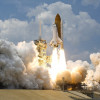The first step towards a space-based gravitational wave telescope has been tested successfully by the European Space Agency (ESA).
Called the LISA - short for Laser Interferometric Space Antenna - pathfinder mission, the two tonne space probe, which was launched in December 2015, has taken up a position about 1.5 million kilometres from Earth in a region called Lagrange point L1.
This is a region of space where the Sun and the Earth's gravitational pull effectively cancel each other out and where objects may be stably "parked" to make observations.
This gravitationally and magnetically neutral zone in space is critical for the operation of the LISA pathfinder probe, which is the forerunner to a gravitational wave detector that will span more than a million kilometres of space when it becomes operational by the 2030s.
Inside the 400 million Euro LISA pathfinder probe are two free-floating cubes. Cast from a gold-platinum alloy, each measures about 5 centimetres across and weighs two kilograms.
A laser beam measures the distance between them to within one billionth of a millimetre (a picometre), while micro-thrusters adjust the position of the spacecraft itself to position and adjust the station of the cubes with minute precision.
The probe "went live" and began transmitting data, which the ESA team say shows that their approach has been successful, on the 23rd February of this year.
根据to project scientist Paul McNamara, "I think we can now say that the principle has worked!"
The LISA pathfinder mission aims to establish the operating parameters and to test the approaches that will be used in the main 1 billion Euro eLISA telescope currently scheduled for 2034.
This will comprise a constellation of three spacecraft between which will be transmitted pulses of laser light over distances of a million kilometres.
These will be able to detect and resolve the sources of passing gravitational waves, which will momentarily distort the fabric of space and change the time taken by the laser beams to pass between the two probes.
Owing to its vast size, eLISA will be able to detect gravitational waves of much longer wavelengths than those that can be sampled using ground-based observatories like LIGO, where the first detection of gravitational waves was confirmed last month.
Success for the LISA Pathfinder probe was regarded as a prerequisite before ESA committed itself to the full telescope. Scientists were also hoping that gravitational waves would already have been picked up by Earth-based detectors before the project kicked off.
Speaking toNaturemagazine, Stefano Vitale, a physicist at the University of Trento, Italy, said "It looks like these two conditions have been fulfilled in the same month. So it's really our month!"









Comments
Add a comment